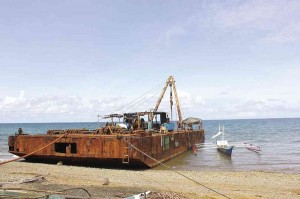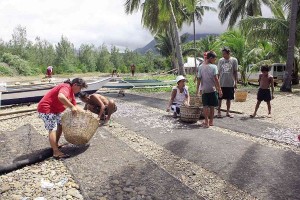How Sibuyan tragedy changed rescuers’ lives

THE BARGE of private salvor Hi-Cap Metal Trading is parked on the shore of Taclobo in San Fernando, Romblon, for the full recovery of MV Princess of the Stars. PHOTOS BY MARICAR CINCO
Call of duty might have brought them to Romblon, but something else made them stay. Five years since MV Princess of the Stars sank off the coast of Sibuyan Island in Romblon, the Inquirer met the same faces of rescuers and divers working on the full recovery of the vessel.
“I had not gone home since, so my wife and I decided that they move in instead and we permanently stay here,” said Petty Officer 1 Armando Leonida.
The Cebu-bound MV Princess of the Stars sank with more than 800 people on board. Only around 300 bodies have been recovered since. The rest were believed to be still trapped inside the wreck.
“We can’t just leave the bodies down there, lest they would be buried there for good,” Leonida said.
Leonida, 43, who heads a Philippine Coast Guard team in the salvaging operation, bought a piece of land in the coastal village of Taclobo, close to his present workplace or where the ship sank on June 21, 2008. His family transferred from Manila this May in time for his four children to enroll in an elementary school in San Fernando town.
Article continues after this advertisementTraveling back home then, which takes about 15 hours of boat ride to reach the Batangas port and costs over P1,000 one way, seemed impractical to Leonida.
Article continues after this advertisementAs a team leader, he volunteered to stay and man the site, as well as secure their diving equipment, when the other divers took their days off.
Cost of living
From eight Coast Guard personnel, only Leonida and two other divers were left to complete the retrieval work, which may take another five years.
The two divers—one originally from Davao and the other from Tablas Island in Romblon, are also about to start their new lives with their wives, whom they met in the course of their duty in Sibuyan. “They said Sibuyan women are beautiful,” Leonida said.
But what convinced him most to relocate his family was the peaceful community, as well as the low cost of living. “Where else can you buy a 200-square-meter property for P50,000?” he

MEN AND women in Taclobo, San Fernando, Romblon, in Sibuyan Island, dry up their fresh catch of anchovies.
said.
“Also in Manila, we had to spend for the water we drink, but here it’s free.”
Health
But the Coast Guard men were not only the new neighbors in town. Vener Balsamo, project engineer of the ship’s salvor, has also brought his parents to the island. He also met his fiancée on the island, said his mother Jesusima, 67.
“We noticed that since we moved here, my husband and I had never been sick,” Jesusima said.
Balsamo’s parents left their home in Bacoor City in Cavite in 2011 to build a hut, also on the coast of Taclobo.
“Unlike in Cavite, there’s no pollution here and everything we eat is fresh. I won’t have to eat fish caught through dynamite fishing anymore,” Jesusima said.
She said it took her some time, though, to adjust to the island community that has only one automated teller machine and no shopping mall, and where the cell phone signal is not always reliable.
“Before, I used to cry at night as it was so quiet the only sound you hear comes from insects,” she said.
What concerns Jesusima now are the transportation and the hospitals. “There’s a clinic at the poblacion, but the closest hospital is in Cajidiocan,” she said. Cajidiocan is the town next to San Fernando, while the next one is in Roxas City in Capiz, a five-hour ride by boat.
“People here rarely get sick anyway,” Leonida said.
“Maybe that’s also a reason why stabbing incidents are uncommon, unlike in Manila, because people know that hospitals are too far,” he added.